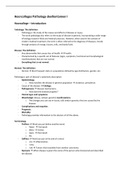Class notes
LECTURES notes Pathology Exam I
- Course
- Institution
This document contains extensive notes of the lectures that belong to partial exam I. Many pictures are included with an explanation as clear as possible. It is in it English because the exam will also be in English.
[Show more]



